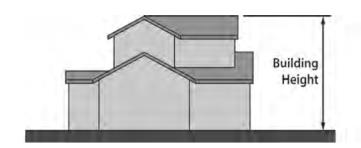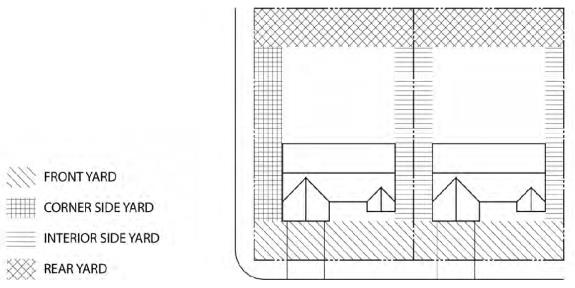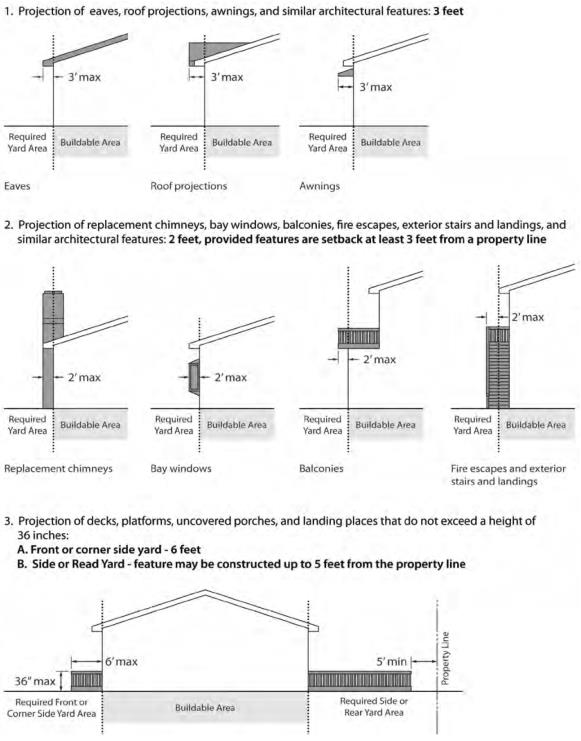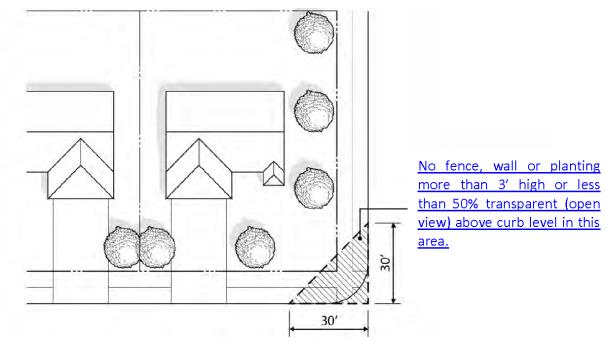Division IV. Site Development
Chapter 18.60
GENERAL DEVELOPMENT STANDARDS
Sections:
18.60.030 Height measurement and exceptions.
18.60.040 Setback requirements and exceptions.
18.60.010 Purpose.
The purpose of this chapter is to provide the process for determining building height and setbacks and identifying exceptions to height limits and setback requirement. Additionally, this chapter describes special site development requirements. (Ord. 738 § 1 (Exh. A) (part), 2013).
18.60.020 Applicability.
The rules for determining dimensional requirements in this chapter apply to all city zoning districts. The dimensional requirements are included in Division III (Zoning Districts), more specifically Table 18.38.040-1 (Development Standards for Residential Districts), Table 18.42.040-2 (Development Standards for Commercial and Medical/Professional Office Districts), Table 18.46.040-1 (Development Standards for Industrial Districts), and Table 18.50.040-2 (Development Standards for Public/Quasi-Public and Parks and Recreation Districts). (Ord. 738 § 1 (Exh. A) (part), 2013).
18.60.030 Height measurement and exceptions.
The following rules apply to the calculation and determination of height of structures in the city. The intent of these regulations is to provide for compatibility in the measure of building height under a variety of circumstances (e.g., sloped site).
A. Height Measurement. The height of a structure shall be measured as the vertical distance from the finish grade to the highest point of the roof of the structure. The measure excludes architectural features and appurtenances such as, but not limited to, chimneys, antennas, elevators, and similar mechanical equipment.
Figure 18.60.030-1 Height Measurement
B. Height Limits. Height limits are established throughout this title. Primarily, height limits are listed in Division III (Zoning Districts), where they are listed by zoning district. Additional height limits are established for accessory structures (Chapter 18.62), fences and walls (Chapter 18.70), and signs (Chapter 18.82). Height limits are measured as the vertical distance from the finish grade of the site to an imaginary plane located the allowed number of feet above and parallel to the finish grade.
Figure 18.60.030-2 Height Limit Measurement
C. Height Exceptions. The following features are excluded from height limits, provided they do not exceed fifteen feet in height above the structure (see Figure 18.60.030-3, Height Exceptions):
1. Flues.
2. Chimneys.
3. Spires, bell towers, or similar architectural features.
4. Additional height over fifteen feet may be considered through the minor adjustment process (Section 18.16.110).
Figure 18.60.030-3 Height Exceptions
(Ord. 738 § 1 (Exh. A) (part), 2013).
18.60.040 Setback requirements and exceptions.
A. General Yard and Setback Requirements.
1. Required Yard Area. Except as otherwise specified in this title, required yard areas shall be kept free of buildings and structures.
2. Exclusivity of Required Yard Area. No yard or other open space provided around any building for the purpose of complying with this title shall be considered as providing a yard or open space for any other building or structure.
B. Front Yards. Generally, the front yard setback is determined by the front lot line, which is the lot line paralleling the street. For corner lots, the front lot line is determined by the orientation of the front entrance of the primary building. However, for flag lots and other irregularly shaped parcels, the front lot line is determined to be the narrowest portion of the lot. For flag lots, this excludes the narrow portion of the lot that represents the “pole.”
C. Street Yards. Except as otherwise permitted, a street yard shall be used only for landscaping, pedestrian walkways, driveways, or off-street parking.
D. Rear and Interior Side Yards. Except as otherwise permitted, these yards shall be used only for landscaping, pedestrian walkways, driveways, off-street parking or loading, recreational activities or facilities, or similar accessory activities.
1. Vertical Clearance. Except as otherwise provided in this title, every part of a required yard shall be open from its lowest point to the sky unobstructed. Building overhangs, bay windows, and other such elements may intrude as permitted, pursuant to subsection E of this section (Allowed Encroachments or Projections into Required Yards).
2. Corner Lots. In the case of a lot abutting two or more streets, the main buildings and accessory buildings shall be erected so as not to encroach upon the required front and street side yards.
3. Double-Frontage Lots. Where a double-frontage lot (defined as a lot with property line along two opposing streets) has a depth of one hundred twenty-five feet or more, such lot may be treated as two lots, with the rear line of each approximately equidistant from the front lot lines, provided all yard requirements are met.
4. Setback Measurement. The setback of all buildings and structures shall be measured at a right angle from the property line as listed below. Except as permitted in subsection E of this section (Allowed Encroachments or Projections into Required Yards), or as otherwise specified in this title for specific types of structures (e.g., accessory structures, signs) or through the issuance of an adjustment, structures shall not extend beyond required setback lines.
Figure 18.60.040-1 Setback Measurement
E. Allowed Encroachments or Projections into Required Yards. In addition to the structures listed in Chapter 18.62 (Accessory Structures) and Chapter 18.70 (Fences, Walls, and Screening), the following structures and architectural features attached to the main building may project into the required yards:
1. Residential Encroachments.
a. Eaves, roof projections, awnings, and similar architectural features may encroach into required yards a maximum distance of three feet, provided such appendages are supported only at, or behind, the front building setback line, and a minimum of four feet from any side lot line.
b. Replacement chimneys, bay windows, balconies, media centers, fire escapes, exterior stairs and landings, and similar architectural features may encroach a maximum distance of two feet into required side yards or three feet into any required rear yard, provided such features shall be at least three feet from a property line.
c. Decks, platforms, uncovered porches, and landing places that do not exceed a height of thirty-six inches above grade may encroach into any front or corner side yard a maximum distance of six feet and project into any rear or interior side yard up to five feet from the property line.
d. Projections are not permitted over a lot line and encroachment provisions would not apply to zero lot line situations.
2. Nonresidential Encroachments.
a. Eaves, roof projections, awnings, and similar architectural features when located at least eight feet above grade may encroach into required yards a maximum distance of three feet; provided, that such feature shall be at least four feet from a property line.
b. Fireplaces, chimneys, bay windows, balconies, fire escapes, exterior stairs and landings, and similar features may project into the required yard a maximum distance of two feet; provided, that such features shall not occupy more than twenty-five square feet of each required yard and shall be at least four feet from a property line.
c. Projections are not permitted over a lot line and encroachment provisions would not apply to zero lot line situations.
Figure 18.60.040-2 Residential Encroachments
(Ord. 738 § 1 (Exh. A) (part), 2013).
18.60.050 Vision triangle.
Vision triangles apply only to corner lots. The boundaries of a vision triangle are formed by drawing lines from the point of intersection of a lot’s street corner property lines to points thirty feet along the two property lines and then connecting the two points with a straight line.
A. Residential Districts. No wall, fence, or hedge higher than three feet shall be erected or maintained on a corner lot in any residential district within the area called the vision triangle.
B. Other Districts. In any district, other than a residential district, no wall, fence, hedge, or other obstruction to view shall be erected or maintained between three feet and eight feet above grade on any corner lot within the area called the vision triangle.
C. Planting and Landscape Materials. Planting and landscape materials (except for street trees) shall not exceed three feet in height within the vision triangle area or if taller it shall have a minimum of fifty percent opacity to allow views through the landscaping material (opacity measurement also includes fencing materials).
Figure 18.60.050-1 Vision Triangle
(Ord. 738 § 1 (Exh. A) (part), 2013).


